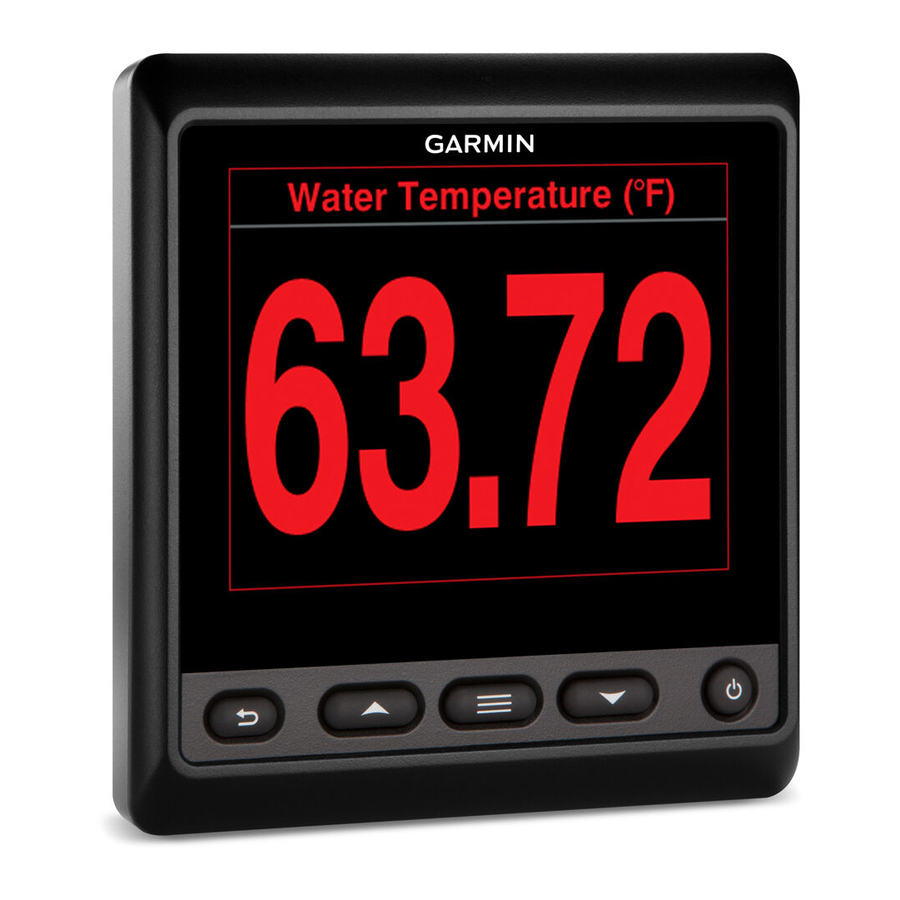Garmin GMI 20 Посібник користувача - Сторінка 5
Переглянути онлайн або завантажити pdf Посібник користувача для Морське обладнання Garmin GMI 20. Garmin GMI 20 10 сторінок. Digital marine instrument display
Також для Garmin GMI 20: Інструкція з монтажу (4 сторінок), Інструкція з монтажу (4 сторінок)

Introduction
See the Important Safety and Product Information guide in the
product box for product warnings and other important
information.
Device Configuration
NOTE: Certain functions are available only if the appropriate
sensors are connected to the device.
The GMI 20 allows you to view data provided by sensors
connected to the device on a NMEA 2000 ® or NMEA ® 0183
network.
Select to return to the previous menu or to the instrument
screen.
Select to view the menu for an instrument or screen.
or
Select to scroll through instrument pages and menus.
Select to view the display settings.
Select twice to view backlight settings.
Hold to view the power off settings.
Profiles
Profiles are collections of instrument pages that can be
customized. Profiles can be made up of instrument pages that
display similar data, such as fuel data or engine data.
During the initial setup, you can select one of four preset
profiles, or you can create a custom profile. You can select a
different profile at any time.
Powerboat: By default, this page displays instrument pages
that show GPS speed information, position coordinates,
bearing to waypoint, distance to the next waypoint, and a
GPS trip odometer.
Sailboat: By default, this page displays instrument pages that
show apparent wind speed, GPS heading, GPS speed,
position coordinates, bearing to waypoint, distance to the
next waypoint, and a GPS trip odometer.
Fishing: By default, this page displays instrument pages that
show GPS speed, water temperature, and depth.
Engine/Fuel: By default, this page displays instrument pages
that show engine and fuel information. Available engine
information includes RPM, trim, temperature, voltage, oil
pressure, fuel pressure, boost pressure, and coolant
pressure. Fuel information includes fuel flow rate, fuel tank
level, estimated total fuel onboard, fuel pressure, fuel
economy, and cruising range.
Introduction
WARNING
Custom (1,2,3): Empty profiles that allow you to build a new
custom profile. Custom profiles do not contain any preset
instrument pages.
Selecting a Profile
1
Select
> Profiles > Select Profile.
2
Select a profile.
Renaming a Profile
1
Select
> Profiles > Rename Profile.
2
Select
or
to scroll through the letters.
3
Select Select to select a letter.
4
Select Done.
Creating Custom Profiles
You can create up to three custom profiles. You can add up to
ten pages from multiple instrument collections to a custom
profile.
1
Select
> Profiles > Select Profile.
2
Select Custom 1, Custom 2, or Custom 3.
3
Select a page.
4
Select an instrument or multiple instruments.
5
Select an option:
• To continue adding instrument pages to the custom
profile, select Yes.
• To complete the custom profile, select No.
Locking a Profile
You can lock a profile so no changes can be made to the data
fields, page layout, or number of pages that can display at one
time.
Select
> Profiles > Lock Profile > Yes.
Unlocking a Profile
Select
> Profiles > Unlock Profile > Yes.
Restoring Profiles to their Default Settings
You can restore unlocked profiles to their factory default
settings.
1
Select
> Profiles > Reset Defaults.
2
Select Current Profile or All Profiles.
3
Select Yes.
Instrument Pages
Cycling Through Instrument Pages
From the Instrument page, select
Using Auto Scroll
You can use auto scroll to automatically cycle through all of the
instrument pages.
1
From the instrument page, select
2
Select System > Auto Scroll > On.
3
Select a time duration for how long each instrument page
displays.
4
Select Done.
Configuring the Data Fields
Data provided on an instrument page can be shown in various
ways depending upon the instrument page that is displayed.
Select
> Configure Data Fields.
or
.
.
1
